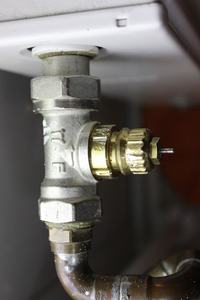

Czy wolisz polską wersję strony elektroda?
Nie, dziękuję Przekieruj mnie tammichalpolo wrote:Everything was done around the radiator, but he was not moved.



michalpolo wrote:Probably in the top section of this pipe there is another vent that needs to be opened to fill the pipe with water "
michalpolo wrote:
it is very strange, but not the upper valve and the lower screw on the left (not visible in the photo) released the air. on another forum someone wrote that this is a sign that "there is air in the drainage riser and the problem may return. Probably in the top section of this pipe there is another vent that needs to be opened to fill the water pipe"
roman 18 wrote:hello, buddy, try another method of bleeding, close the return valve at this radiator and then loosen the nut on the flare nut of the thermostatic valve, probably in this elbow the air is blocking the flow of the liquid. greetings
roman 18 wrote:hello, buddy, try another method of bleeding, close the return valve at this radiator and then loosen the nut on the flare nut of the thermostatic valve, probably in this elbow the air is blocking the flow of the liquid. best regards, heating on maxsa.
michalpolo wrote:it's an apartment in Denmark
brofran wrote:michalpolo wrote:it's an apartment in Denmark
I conclude that you are renting. Therefore, report the problem to the owner, he is obliged to provide you with appropriate conditions, because you pay for it. You can see that something in the installation has been corrected recently, because it certainly didn't heat well, but the effects of the corrections were not. You are unlikely to do anything with it yourself, since all simple prompts have failed.
Samuraj wrote:Most likely there is no refrigerant flow through the return. Hence, the radiator is warm for a moment after deaeration.
I propose to turn off the supply and return of the heater, unscrew the air vent and overflow the heater by unscrewing the return.
Samuraj wrote:Exactly as you write. Perhaps there is some muck in the return valve and hence the lack of flow or, even worse, the return curved somewhere below. After unscrewing the vent, it will command pressure from the heater even though both valves are closed.
Then slowly unscrew the return and watch what happens.
Samuraj wrote:Pour out, you will not pour out, because where is this water to go out overhead?
The point is to check if the return is clear. Unscrew slowly and drain 3 liters of water with the air vent.
Samuraj wrote:1) We turn both: the one at the bottom and the top
2) Loosen the air vent
3) We pour a little water, max 100ml more will not fly
4) Unscrew the bottom valve slightly
5) We pour about 3l of water through the vent
6) We turn the bottom one
7) We tighten the air vent
8) Unscrew the upper and lower valves
Samuraj wrote:No flow. Your power supply is hot, but there is no flow through the radiator and it is cool when it gives off heat.
Pour hot water into the bathtub, it will be warm for a while and then cool down. Remove the plug and pour hot water at the same time - the water in the tub will be hot all the time. Well, unless the drain will be larger than the power supply.
How many of these valves do you have on this radiator? Three ?
Top left and bottom and bottom right?